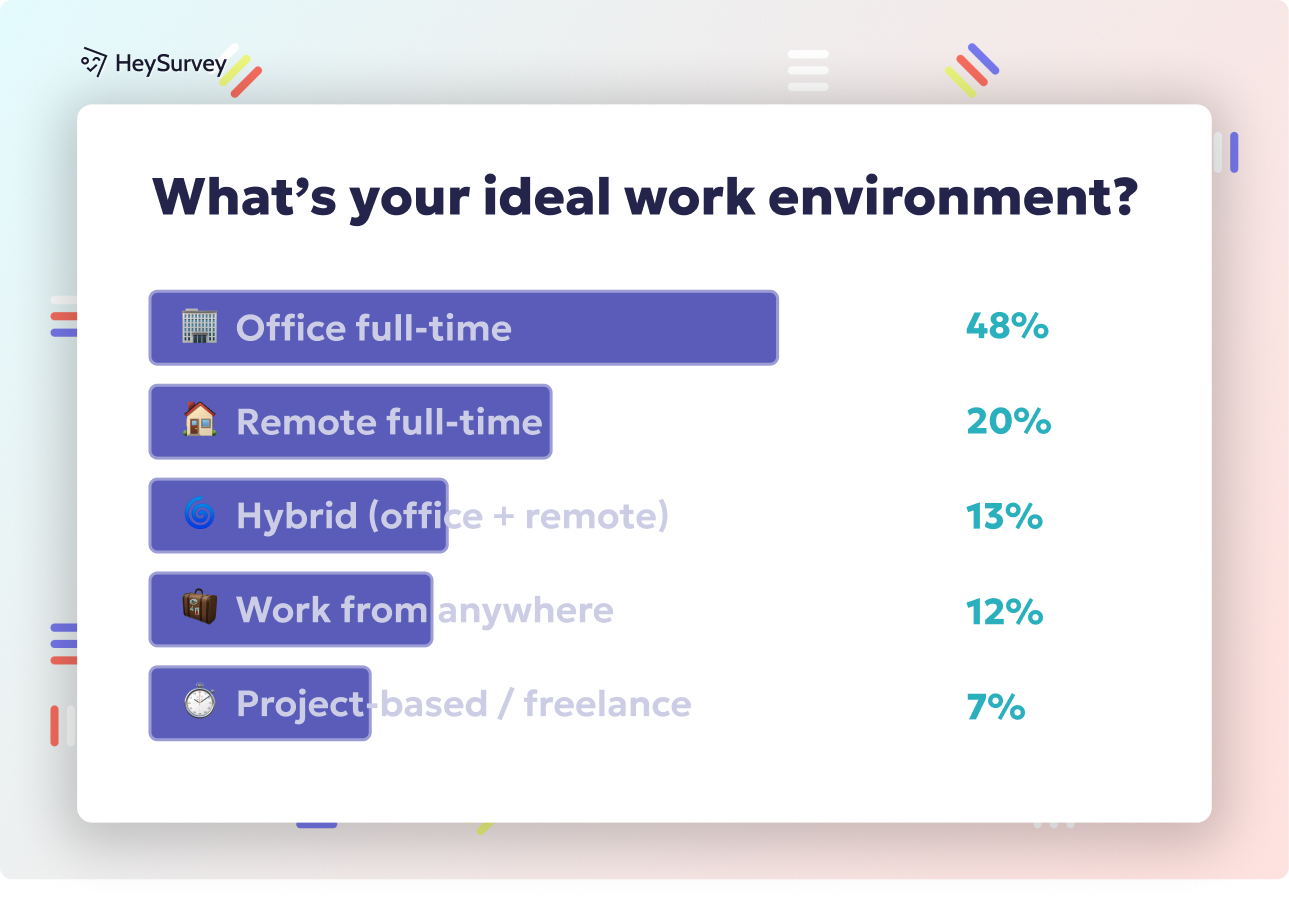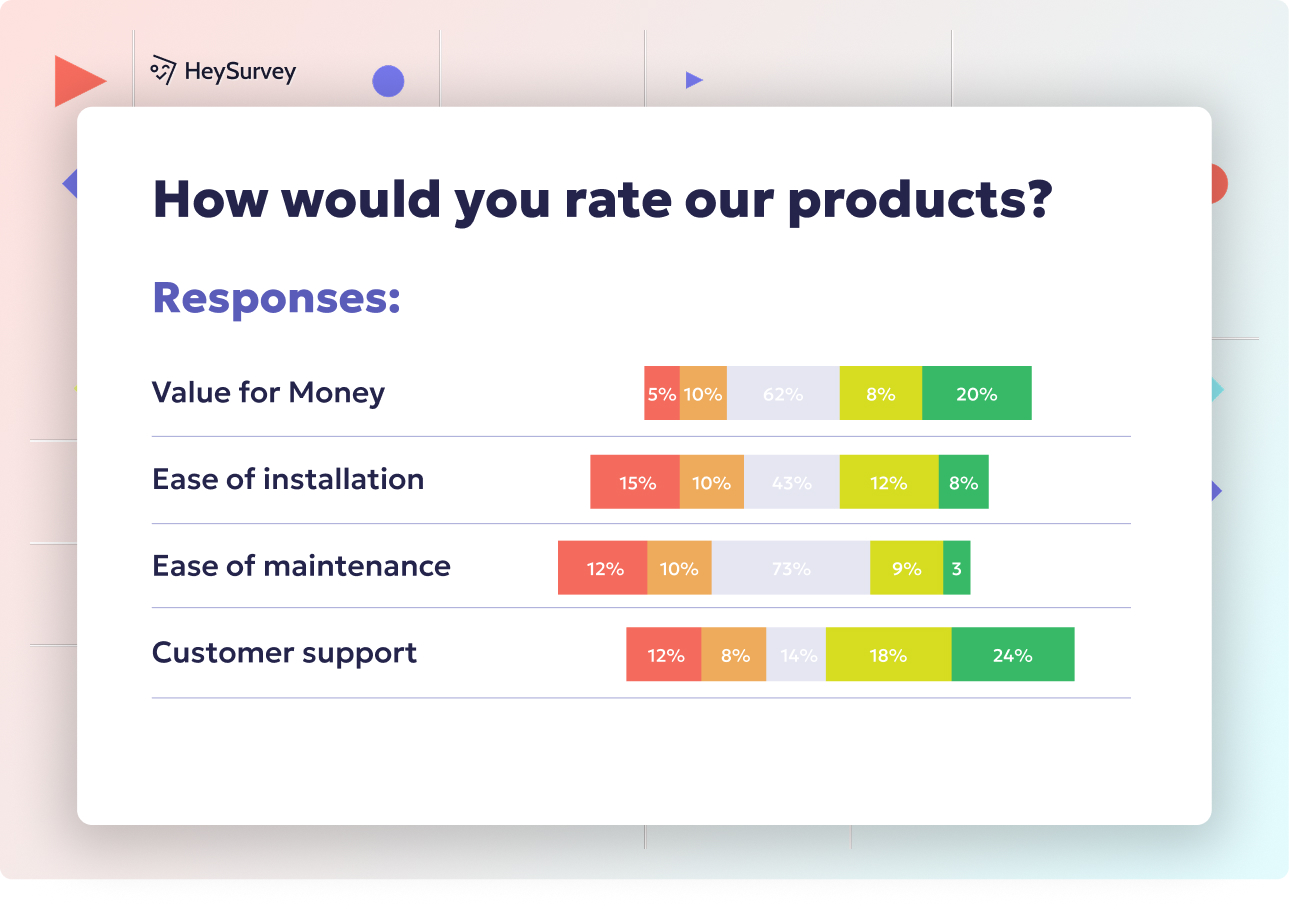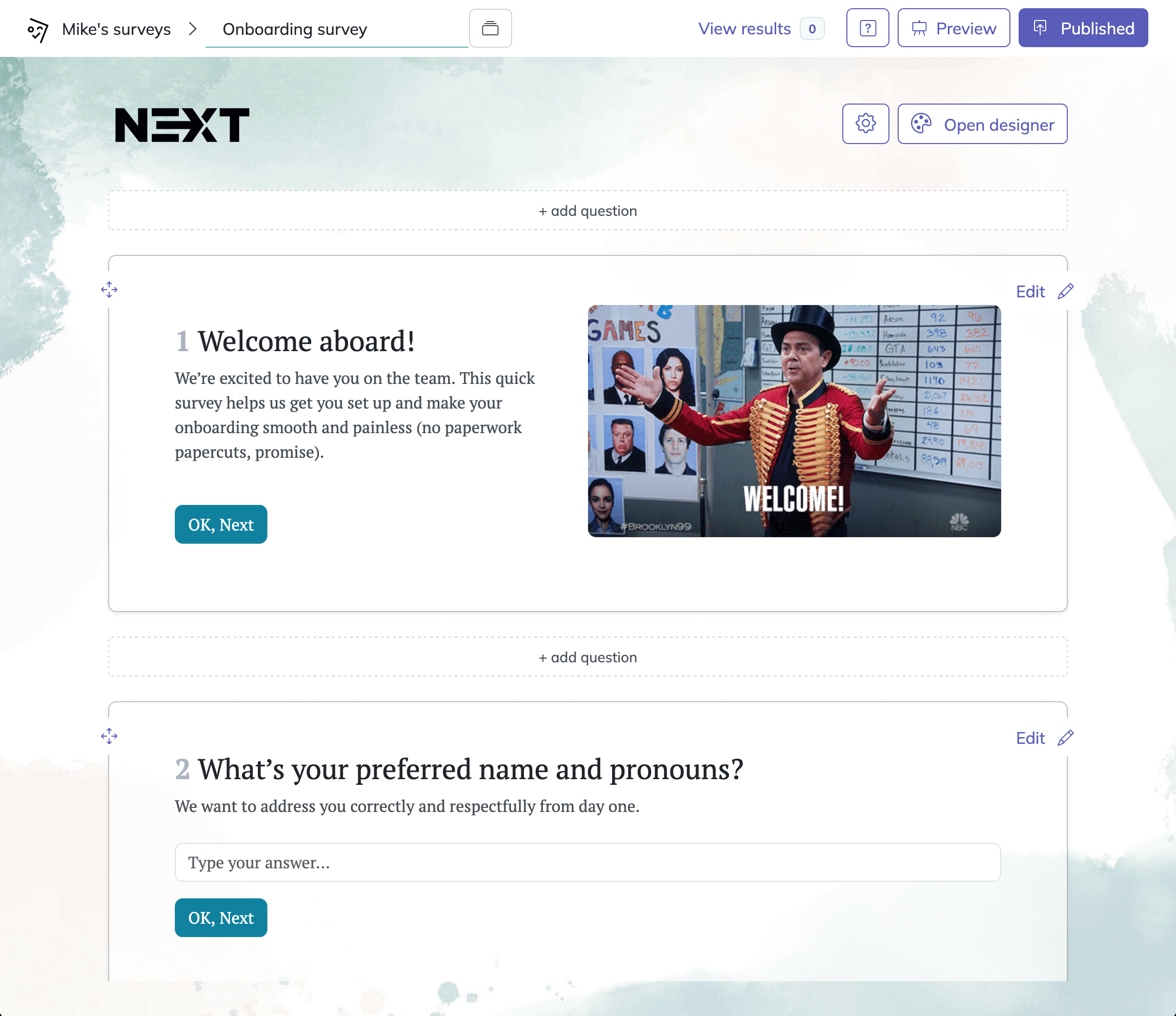28 Questions to Ask About Stress Survey Questions for Impact
Discover 30+ sample questions to ask about stress survey questions for workplace, academic, financial, health, parenting, caregiving, and remote work.
Stress surveys are your secret decoder ring for uncovering what’s really going on beneath the surface in workplaces, schools, homes, and remote offices. By asking the right stress assessment questions, you can shine a light on hidden hot spots, boost wellbeing, and make smarter, data-driven decisions. Whether you’re using a classic stress questionnaire or an employee stress survey, targeting the right issues delivers true ROI for your team, your students, or even your household.
Workplace Stress Survey
Understanding Employee Stress in the Workplace
Job-related stress is a sneaky culprit that drains morale and productivity. Work pressure, confusing expectations, endless email ping-pong, and even a boss’s mood can crank up the stress-o-meter at lightning speed. Heavy workloads and “do more with less” cultures push employees to burnout, while fuzzy job descriptions leave people wondering if they’re rowing or just bailing out a sinking ship.
According to authoritative sources like OSHA and the World Health Organization, workplace stress is more common than office birthday cakes. In fact, WHO reports that depression and anxiety, often triggered by workplace woes, cost the global economy $1 trillion each year in lost productivity. OSHA links job stress to everything from headaches to heart attacks—yikes! Pinpointing exactly what your team is feeling helps companies tweak workloads, clarify policies, and foster supportive environments that actually keep people engaged (and alive).
When and Why to Deploy an Employee Stress Survey
Deploy these surveys when you want real clarity:
* During onboarding, to spot shaky spots before patterns form
* Annually—or better, quarterly—to track trends in employee stress
* After mergers or big leadership shakeups
* When you roll out major policy tweaks or downsizing initiatives
Periodic surveys guide top-down decisions but also build trust by showing employees you want real feedback, not just lip service.
Employee Stress Sample Questions
How often do tight deadlines cause you to feel overwhelmed?
Do you have clear expectations about your role and responsibilities?
How supported do you feel by your immediate supervisor when work becomes stressful?
In the past month, how frequently have you worked beyond your scheduled hours?
How comfortable are you taking mental-health days when needed?
Ensuring anonymity in employee stress surveys is crucial, as it encourages honest feedback and increases response rates. (fisher.osu.edu)

Creating your stress survey with HeySurvey is a breeze! Just follow these 3 easy steps, and you’ll be ready to gather powerful insights in no time.
Step 1: Create a New Survey
Head to the HeySurvey dashboard and click “Create Survey”. You can start from scratch with a blank survey, or save time by picking a pre-built stress survey template tailored to your topic. This gets you going with an organized structure and relevant questions already in place. Give your survey an internal name so you can find it easily later.
Step 2: Add Your Questions
Once inside the Survey Editor, add more questions or tweak existing ones by clicking “Add Question”. Choose from various question types like multiple choice, scale questions, or open text, depending on what you want to learn. Customize question text, add descriptions, and mark essential questions as required. Don’t forget, you can add images or use markdown formatting to make questions clearer and engaging.
Step 3: Publish Your Survey
Once your questions are set and you’re happy with the flow, hit the “Publish” button. Publishing generates a unique link you can share with your audience. To publish and track responses, you’ll need to create a HeySurvey account if you haven’t already—it’s free and quick. Now your stress survey is live and ready to collect valuable feedback!
Bonus Step: Apply Branding
Make your survey shine by adding your logo and customizing colors, fonts, and backgrounds in the Designer Sidebar. This ensures your stress survey matches your organization’s style and feels professional.
Bonus Step: Define Survey Settings
Use the Settings Panel to set start/end dates, limit the number of responses, or create a custom thank-you page URL where respondents land after completing the survey. You can also enable options like showing respondents the results or allow anonymity to make people feel more comfortable sharing sensitive stress-related answers.
Bonus Step: Add Branching for Smarter Flows
If you want to tailor the survey experience, try branching. This means certain questions only appear based on previous answers—for example, asking more about financial stress only if someone indicates money worries earlier. Branching helps keep surveys relevant and less overwhelming for respondents.
Ready to get started? Click the button below to open a stress survey template and customize it your way in HeySurvey!
Academic Stress Survey (Students)
Pinpointing Student Stress Triggers
Academic stress is practically a rite of passage, but sometimes, it shifts from motivational to simply overwhelming. The pressure can come from a monster course load, finals week, making friends, or keeping up with group projects while dealing with Wi-Fi that has all the reliability of a magic trick gone wrong. New learning technologies and remote classes pile on fresh hurdles, leaving students digitally connected but emotionally zapped.
The American Psychological Association finds that nearly half of students report feeling overwhelmed by their responsibilities. When unaddressed, academic stress can tank grades, affect mental health, and even lead to chronic anxiety. By asking targeted survey questions about workload, exams, and support, schools and colleges can not only spot red flags but also fine-tune academic resources and faculty support systems.
Best Times to Survey for Academic Stress
- Run pulse checks mid-semester to catch burnout before finals hit
- Conduct pre-exam diagnostics to help counseling teams deploy support
- Use during first-year orientation to set benchmarks and tailor onboarding programs
Understanding where students struggle helps schools design better resources and eases transitions for incoming and returning students.
Academic Stress Sample Questions
How anxious do you feel when thinking about upcoming exams?
Do you feel you have enough resources to manage your study workload?
How often does technology (learning platforms, Wi-Fi issues) add to your stress?
How supported do you feel by faculty when you’re struggling?
In the past two weeks, how many nights have you slept fewer than six hours?
The Beck Anxiety Inventory (BAI) is a 21-item self-report questionnaire designed to measure the severity of anxiety in individuals aged 17 and older. (en.wikipedia.org)
Financial Stress Survey
Exploring Financial Strain and Its Ripple Effects
Money might not buy happiness, but financial stress definitely buys headaches. Worries about debt, savings, inflation, or surprise bills can weigh down anyone. This kind of stress doesn’t stay put—it leaks into health, work performance, and personal relationships.
With rising living costs and surprise expenses always lurking around the bend, it’s no wonder people are losing sleep over their bank balances. Surveys reveal that high financial stress is linked to everything from migraines to high blood pressure. Tackling these concerns with the right financial stress survey lets organizations and communities uncover where people genuinely need help—like savings education or debt counseling—so they can offer targeted, practical support.
When to Use Financial Stress Surveys
- During financial-wellness program rollouts to tailor offerings
- While enrolling in new employee benefits to encourage utilization
- For community assistance planning targeting at-risk groups
- As part of annual HR evaluations to assess changing economic climates
Collecting data on money worries empowers decision-makers to lighten the load, not just nod sympathetically.
Financial Stress Sample Questions
How confident are you in covering an unexpected $500 expense?
How frequently do you worry about meeting monthly bills?
Do you feel your current income keeps pace with rising living costs?
How aware are you of the financial resources or counseling available to you?
How much stress does debt repayment cause you on a typical week?
Health & Chronic Illness Stress Survey
Unraveling Stress for Patients With Health Challenges
Chronic illness brings its own brand of stress—the kind that sticks with you well after the doctor’s office visit. A new diagnosis can turn plans upside down, and treatment regimens often feel as complicated as assembling flat-pack furniture—with no instructions. Patients juggle medical appointments, medication schedules, and lifestyle changes, all while trying to keep their sanity and independence.
CDC data shows that six in ten adults have a chronic disease, with stress amplifying symptoms and making recovery even tougher. By identifying where the stress hits hardest—like during medication adjustments or major lifestyle changes—healthcare teams can better support patients, reduce non-compliance, and boost quality of life.
The Best Times to Collect Health Stress Data
- At hospital and clinic intake sessions to tailor support right away
- During long-term care or chronic disease management programs
- For employee wellness check-ins among at-risk groups
- After big treatment changes or during transitions in care settings
Well-timed surveys keep support relevant and timely, not just “one size fits nobody.”
Health & Chronic Illness Stress Sample Questions
How often do you feel anxious about managing your health condition?
How confident are you in following your treatment regimen?
How supported do you feel by healthcare providers regarding stress management?
How much does your condition interfere with daily activities?
Do you have access to mental-health resources tailored to your diagnosis?
Effective stress surveys for chronic illness patients should use clear, concise questions, avoid jargon, and include a mix of question types to capture comprehensive insights. (linkedin.com)
Parenting Stress Survey
Cracking the Code on Parenting Pressure
Parenting might be the most rewarding tough gig out there—but it’s also a stress magnet. Parents juggle after-school meltdowns, schedule gymnastics, and ever-climbing childcare bills. Factor in work emails pinging during bedtime stories, and the result is a daily tightrope walk between guilt and exhaustion.
The American Academy of Pediatrics warns that unchecked parenting stress affects not just adults but also children’s well-being. By using specific survey questions to understand what weighs parents down—like lack of childcare or support with behavioral challenges—organizations and doctors can give families practical tools and support.
Smart Times to Use Parenting Stress Surveys
- During pediatric wellness visits to spot early signs of burnout
- With family-support programs to tailor parenting workshops or counseling
- In employer parent-resource groups to design meaningful benefits
- Before and after family transitions such as a new baby or divorce
Unlocking these insights is the key to matching resources with reality—and happier households.
Parenting Stress Sample Questions
How overwhelmed do you feel balancing parenting and other responsibilities?
How often do you have reliable childcare when you need it?
To what extent do you feel guilty about the time you spend at work vs. with your child?
How confident are you in managing your child’s behavioral challenges?
How supported do you feel by your partner or co-parent in parenting tasks?
Caregiver Stress Survey (Elder/Dependent Care)
Revealing the Weight on Caregivers’ Shoulders
Caring for a loved one is an act of love—but it’s also an emotional marathon. The list of challenges is long: managing appointments, administering medications, and carrying out daily care routines, often with little sleep or thanks. Emotional burnout, financial worries, and the looming shadow of anticipatory grief can wear caregivers down faster than any sprint.
AARP caregiver reports highlight that more than 70% of family caregivers experience stress-related symptoms, from chronic fatigue to immune issues. A well-designed caregiver stress survey can flag burnout risk, highlight the need for respite, and spark conversations about financial strain—giving caregivers a pathway to supported, sustainable care.
Top Moments for Caregiver Stress Surveys
- At senior-care and memory-care facilities upon admission and at regular intervals
- During hospice program intake to spot immediate support needs
- For employee caregiver benefits assessments to shape better policies
- After plant closures or community health changes that strain local resources
Reaching out regularly keeps support dynamic rather than static—and helps caregivers feel noticed, not invisible.
Caregiver Stress Sample Questions
How often do caregiving tasks interfere with your personal life?
How physically exhausted do you feel after caregiving duties?
How confident are you in handling medical tasks for your care recipient?
Do you feel you have enough respite or time off from caregiving?
How comfortable are you discussing your emotional challenges with friends or professionals?
Remote Work & Digital Overload Stress Survey
Why Digital Overload Deserves Special Attention
Remote and hybrid work comes with perks—but also a relentless barrage of notifications, Zoom fatigue, and the nagging sense that the workday never ends. The lines between living room and conference room blur, and screen fatigue is the new normal. Watercooler chats have been replaced by endless Slack threads, sometimes making isolation and miscommunication rampant.
Studies have found that more than 50% of remote employees experience significant burnout from constant video meetings and ‘always on’ expectations. Untangling how digital overload affects morale, focus, and life outside work empowers organizations to tailor their wellness strategies—whether that’s encouraging breaks or limiting after-hours pings.
When to Ask About Digital Stress
- Periodically in remote or hybrid teams to prevent burnout from spiraling
- After major tech rollouts or software migrations
- During company wellness weeks or as part of annual engagement surveys
- When signs of isolation or high turnover pop up unexpectedly
These surveys aren’t just about data—they’re about creating workplaces that respect boundaries and foster real connection.
Remote Work Stress Sample Questions
How often do you feel pressure to respond immediately to messages outside work hours?
How many hours per day are you in video meetings?
How isolated do you feel from your team?
How effectively can you disconnect from work at day’s end?
How helpful are your company’s tools in managing workflow without overload?
Dos and Don’ts: Best Practices for Crafting & Deploying Stress Surveys
Crafting Effective Stress Surveys: The Dos
Creating an effective stress survey takes more than copy-pasting a bunch of questions and calling it a day. Precision and empathy must lead the way. Here’s what to do:
- Keep questions short, clear, and to the point to avoid confusion
- Use validated scales, like the Perceived Stress Scale, to ensure reliable, scientific results
- Offer complete anonymity so participants feel safe sharing their truth
- Pilot test your survey with a small group to catch unclear questions or technical hiccups
- Always provide resources or next steps for participants who indicate high stress
By doing these, you’re not just gathering numbers—you’re building trust and sparking meaningful change.
The Stress Survey Don’ts
Every superhero has some kryptonite, and survey designers are no exception. Here’s what to avoid so your stress survey doesn’t flop:
- Don’t use medical diagnoses, unless you’re qualified and legally permitted
- Skip leading questions; neutrality wins every time
- Keep clear of anything too personal or invasive, like demographic details unrelated to your goal
- Avoid survey fatigue—20 pages of questions and you’ll lose even the most motivated respondent
Overloading respondents can backfire, breeding disengagement instead of honesty.
What to Do After Surveying
Once you have your results, the real work—and opportunity—begins. Move right away to:
- Thoroughly analyze your stress survey data
- Communicate findings with empathy and transparency
- Close the feedback loop so participants know their input mattered
- Implement targeted, high-impact stress-reduction interventions
- Re-survey regularly to track progress and adapt as needs change
Every stress survey is a chance to learn, respond, and grow. Bit by bit, you’ll turn the tide on stress—no cape required.
Related Employee Survey Surveys

29 Essential Post Mortem Survey Questions for Project Success
Discover 25+ essential post mortem survey questions to improve projects, boost team morale, and d...

31 Change Readiness Survey Questions to Boost Your Success
Discover 25+ sample change readiness survey questions to assess attitudes, barriers, and confiden...

31 Retreat Survey Questions to Collect Actionable Feedback
Discover 26 essential retreat survey questions to gather actionable feedback before, during, and ...
